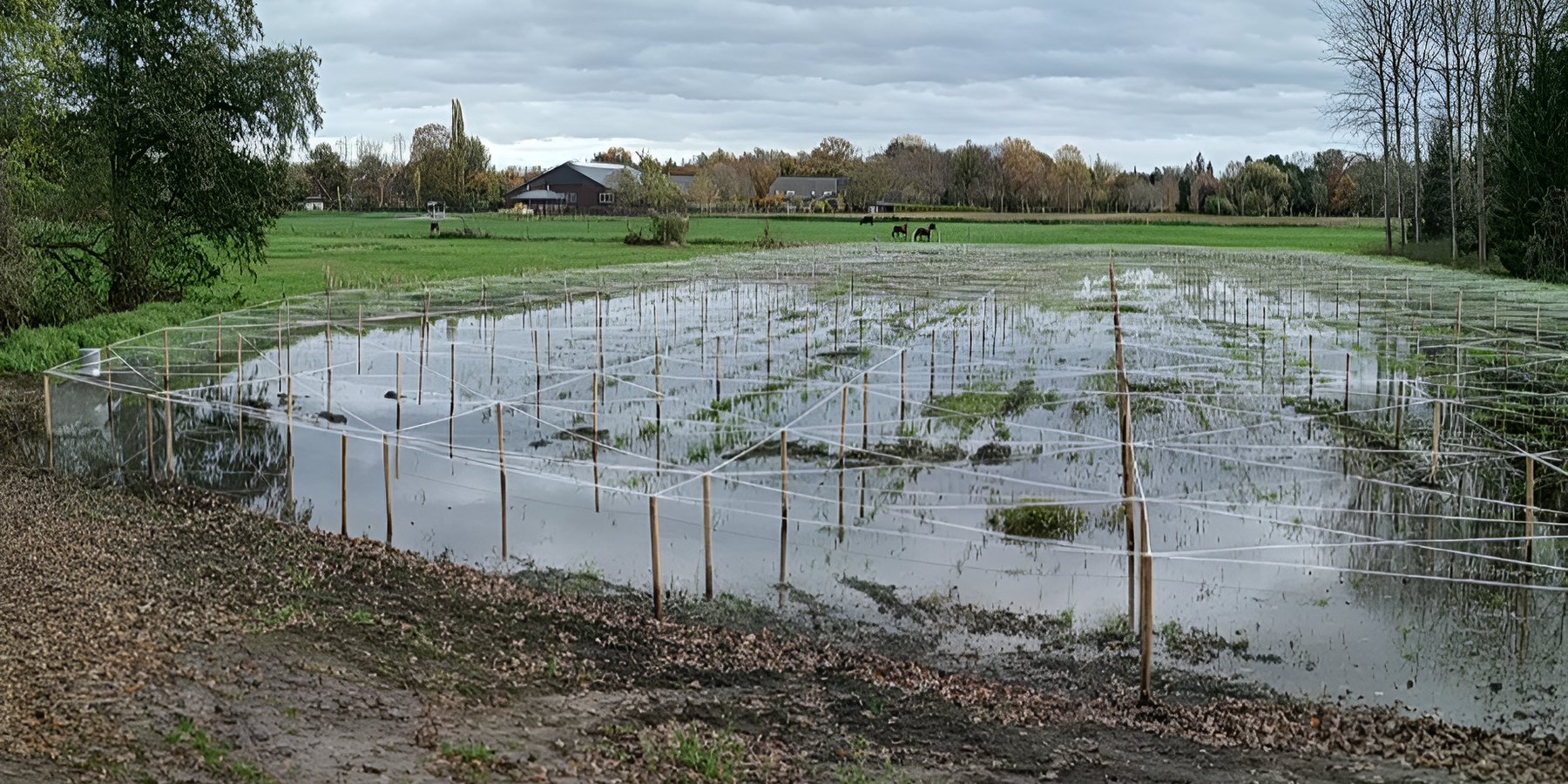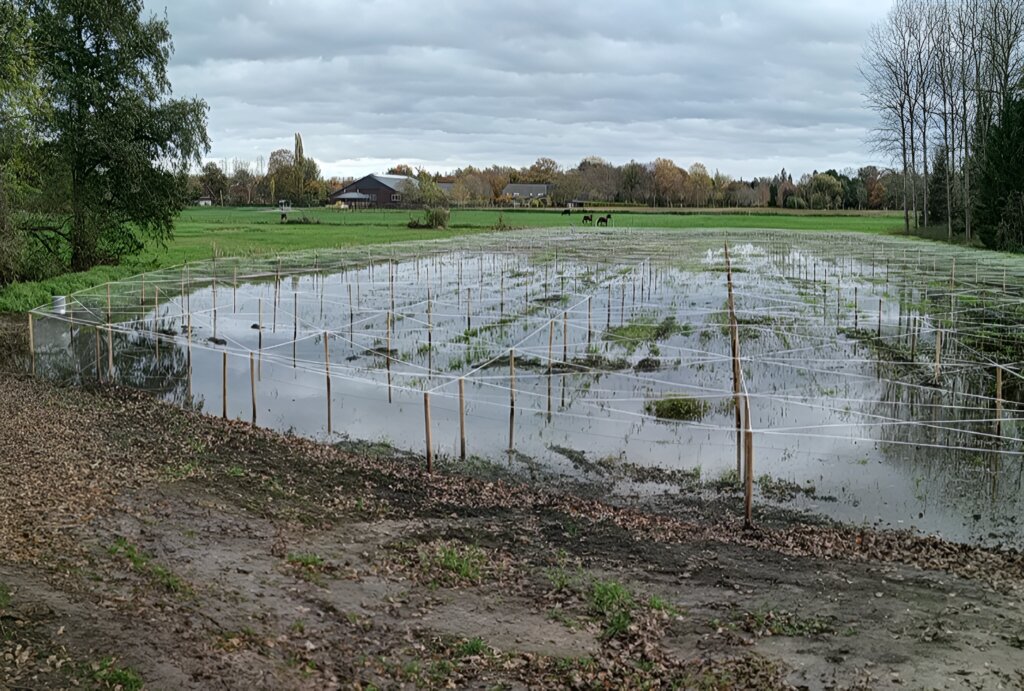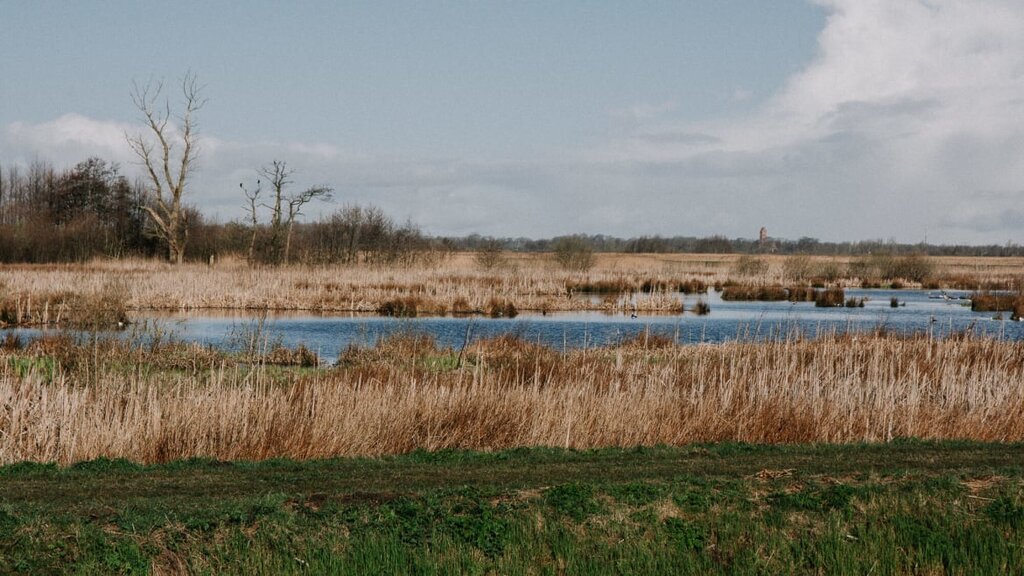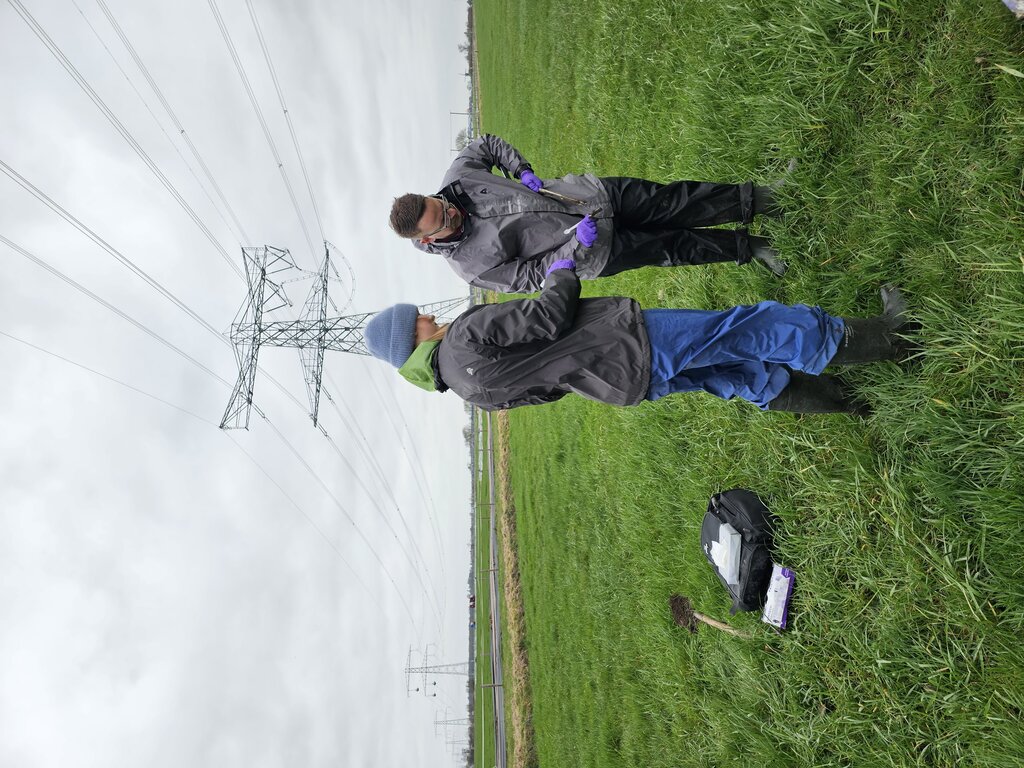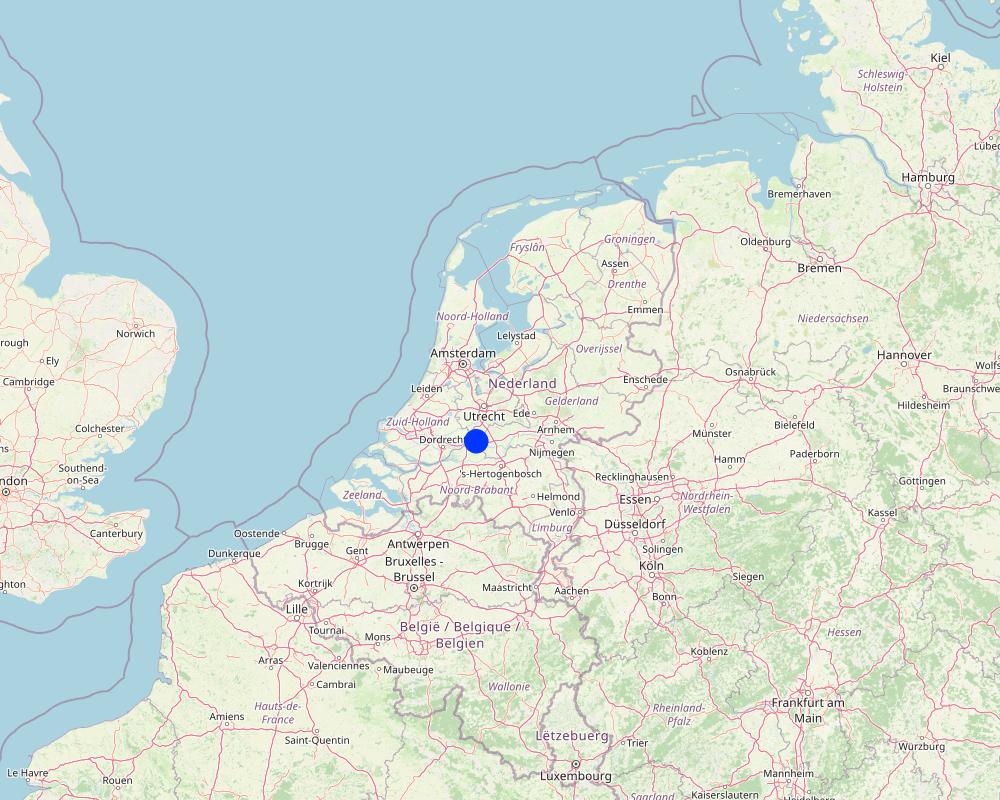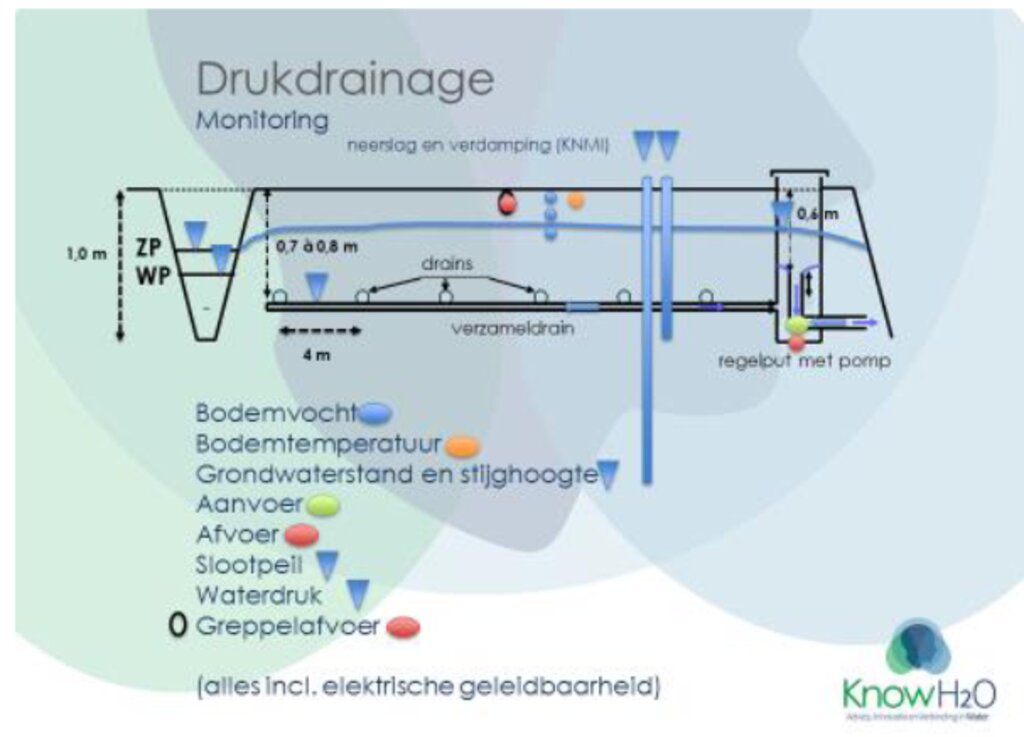Peatland Rewetting [Netherlands]
- Creation:
- Update:
- Compiler: William Powell
- Editor: Carlos Gil Picon
- Reviewers: Rima Mekdaschi Studer, William Critchley
Peatland Rewetting
technologies_7140 - Netherlands
View sections
Expand all Collapse all1. General information
1.2 Contact details of resource persons and institutions involved in the assessment and documentation of the Technology
Key resource person(s)
SLM specialist:
Powell William
JIN Climate & Sustainability
Netherlands
Name of project which facilitated the documentation/ evaluation of the Technology (if relevant)
Land Use Based Mitigation for Resilient Climate Pathways (LANDMARC)Name of the institution(s) which facilitated the documentation/ evaluation of the Technology (if relevant)
JIN Climate and Sustainability (JIN) - Netherlands1.3 Conditions regarding the use of data documented through WOCAT
The compiler and key resource person(s) accept the conditions regarding the use of data documented through WOCAT:
Yes
1.4 Declaration on sustainability of the described Technology
Is the Technology described here problematic with regard to land degradation, so that it cannot be declared a sustainable land management technology?
No
2. Description of the SLM Technology
2.1 Short description of the Technology
Definition of the Technology:
Peatland rewetting is a climate change mitigation technology that involves raising and maintaining high water tables in agricultural peatland through controlled drainage. It reduces soil subsidence and CO2 emissions while preserving biodiversity. This technology offers environmental benefits but faces challenges in policy support and economic viability.
2.2 Detailed description of the Technology
Description:
Peatland rewetting is increasingly being applied in the Netherlands, particularly in the province of Zuid Holland, as a critical environmental management strategy. This technology is implemented in agricultural fields on peatland soil, representing an important shift in land management practices. The method can be characterised by raising and maintaining a high water table in peatland areas through the implementation and careful control of a sophisticated drainage system.
The system's technical infrastructure includes an integrated network of pipes, pumps (including innovative solar-powered options), and strategically placed ditches to control the water level. Advanced monitoring equipment is installed to track water table levels with precision, ensuring optimal management of the wetland conditions. The primary purpose of peatland rewetting is to mitigate climate change by reducing soil subsidence and consequent CO2 emissions from drained peatlands, which globally contribute around 2 Gt of CO2 annually.
Implementation requires several key components and activities. The initial phase involves comprehensive site assessment and installation of the drainage system, including careful placement of monitoring equipment and, where applicable, solar panels for sustainable pump operation. Ongoing maintenance activities are crucial and involve regular system monitoring, component repairs, and water level adjustments to maintain optimal conditions between -10 and +20 cm, as demonstrated in projects like the Swinkels case study.
The benefits and impacts of peatland rewetting are multifaceted. Primary environmental benefits include significant reduction in CO2 emissions by preventing peat oxidation, preservation of valuable peatland habitats and biodiversity, and improved regional water management. The practice also helps avoid substantial costs associated with soil subsidence, such as infrastructure repairs and dam reinforcement that would otherwise be necessary in degraded peatland areas.
From the land user's (farmer's) perspective, the transition to peatland rewetting presents both opportunities and challenges. The main benefits include access to potential subsidies, avoided costs due to soil subsidence, and the opportunity to participate in innovative agricultural practices like paludiculture - the cultivation of wet-tolerant crops such as cattail, which can be used for various applications including fodder. However, farmers may face challenges including significant initial investment costs, the necessity to adapt to new farming techniques and business models, and potential yield impacts during the transition period as they navigate the learning curve of wet agriculture.
Some environmental considerations require careful management. While peatland rewetting generally provides positive environmental outcomes, there can be challenges with nutrient leaching affecting water quality, which necessitates careful monitoring and management strategies. Additionally, stakeholders express concerns about the lack of consistent long-term subsidies and policy support for maintaining these practices, highlighting the need for more robust institutional frameworks to support sustainable peatland management.
Scientific monitoring of these sites, as demonstrated in the LANDMARC project, includes sophisticated tools such as soil sampling for physical and chemical analysis, molecular microbial identification, greenhouse gas measurements, and the use of satellite data and field mapping to track progress and impact. This comprehensive monitoring approach helps ensure the effectiveness of rewetting initiatives and provides valuable data for scaling up these solutions to national and continental levels.
2.3 Photos of the Technology
2.5 Country/ region/ locations where the Technology has been applied and which are covered by this assessment
Country:
Netherlands
Region/ State/ Province:
South Holland
Further specification of location:
Alblasserwaard-Vijfheerenlanden
Specify the spread of the Technology:
- applied at specific points/ concentrated on a small area
Is/are the technology site(s) located in a permanently protected area?
No
Comments:
There is no indication that the sites have a special protected status. The sites are active agricultural lands used for dairy farming. The peatland rewetting sites are on working farms, two organic dairy farms and one conventional dairy farm. The land is described as a permanent grassland. They are actively managed agricultural areas rather than protected natural reserves.
Map
×2.6 Date of implementation
Indicate year of implementation:
2022
2.7 Introduction of the Technology
- regional collaboration
Comments (type of project, etc.):
Key partners of peatland rewetting in this region include farmers, research institutes, local water authorities, and nature organizations
3. Classification of the SLM Technology
3.1 Main purpose(s) of the Technology
- reduce, prevent, restore land degradation
- conserve ecosystem
- preserve/ improve biodiversity
- adapt to climate change/ extremes and its impacts
- mitigate climate change and its impacts
3.2 Current land use type(s) where the Technology is applied
Land use mixed within the same land unit:
No

Grazing land
Animal type:
- cattle - dairy
Is integrated crop-livestock management practiced?
Yes
If yes, specify:
The technology aims to combine peatland conservation and dairy farming. It involves both land and livestock.
Products and services:
- milk
- grass/fodder production, carbon sequestration, water management.
Species:
cattle - dairy
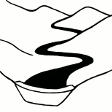
Waterways, waterbodies, wetlands
3.3 Has land use changed due to the implementation of the Technology?
Has land use changed due to the implementation of the Technology?
- No (Continue with question 3.4)
3.4 Water supply
Water supply for the land on which the Technology is applied:
- mixed rainfed-irrigated
Comments:
There will be pressurized draining systems installed, suggesting water management beyond reliance on rainfall.
3.5 SLM group to which the Technology belongs
- water diversion and drainage
- wetland protection/ management
3.6 SLM measures comprising the Technology

structural measures
- S3: Graded ditches, channels, waterways
Comments:
Drainage systems are a significant structural intervention to the landscape. The hydrology of the area is modified through engineered solutions. This technology allows for control of groundwater levels independently from ditch water levels.
3.7 Main types of land degradation addressed by the Technology

chemical soil deterioration
- Cn: fertility decline and reduced organic matter content (not caused by erosion)

physical soil deterioration
- Ps: subsidence of organic soils, settling of soil

biological degradation
- Bc: reduction of vegetation cover
- Bh: loss of habitats
- Bq: quantity/ biomass decline
- Bs: quality and species composition/ diversity decline
- Bl: loss of soil life

water degradation
- Hs: change in quantity of surface water
- Hg: change in groundwater/aquifer level
- Hp: decline of surface water quality
- Hw: reduction of the buffering capacity of wetland areas
Comments:
The most significant issues being addressed by peatland rewetting is Ps: subsidence of organic soils, setting of soil.
3.8 Prevention, reduction, or restoration of land degradation
Specify the goal of the Technology with regard to land degradation:
- prevent land degradation
- reduce land degradation
Comments:
The primary goal of peatland rewetting is to reduce land degradation. By implementing pressurized drainage systems, the technology seeks to slow down the rate of peat decomposition and subsequent soil subsidence.
4. Technical specifications, implementation activities, inputs, and costs
4.1 Technical drawing of the Technology
Technical specifications (related to technical drawing):
Schematic representation of the pressurized drainage system and monitoring setup for a peatland rewetting plot. The system includes drainage pipes at 4m intervals, a central collection pipe, control wells, and various monitoring equipment for measuring soil moisture, groundwater levels, ditch water levels, and water flows. Solar-powered pumps control water levels independently of ditch water levels. Monitoring also includes soil temperatures, biodiversity assessments, and continuous measurement of soil surface height changes.
Author:
Gé van den Eertwegh
Date:
2020
4.2 General information regarding the calculation of inputs and costs
Specify how costs and inputs were calculated:
- per Technology area
Indicate size and area unit:
8.4 ha
other/ national currency (specify):
EUR
Indicate average wage cost of hired labour per day:
60 EUR per hour is the estimated average cost of labour in the Netherlands
4.3 Establishment activities
| Activity | Timing (season) | |
|---|---|---|
| 1. | selection of test plots | Winter/Spring |
| 2. | creating drainage plans | Winter/Spring |
| 3. | obtaining permits | Winter/Spring |
| 4. | installing drainage systems | Summer |
| 5. | installing monitoring equipment | Summer |
| 6. | damming ditches | Late Summer/Early Fall |
| 7. | installing pumps | Summer |
| 8. | setting up reference plots for comparison | Full Year |
| 9. | conducting baseline measurements | Full Year |
Comments:
No clear data available on specific timing, however estimations are made based on the technical requirements and the climate of the Netherlands.
4.4 Costs and inputs needed for establishment
| Specify input | Unit | Quantity | Costs per Unit | Total costs per input | % of costs borne by land users | |
|---|---|---|---|---|---|---|
| Labour | installation | |||||
| Labour | maintenance | |||||
| Equipment | drainage and collection pipes | |||||
| Equipment | pumps and solar panels | |||||
| Equipment | control wells | |||||
| Equipment | monitoring equipment (soil moisture sensors, etc.) |
If you are unable to break down the costs in the table above, give an estimation of the total costs of establishing the Technology:
579000.0
If land user bore less than 100% of costs, indicate who covered the remaining costs:
There is local and national government involvement in sharing the costs. Farmers also contribute 25% of the installation costs and provide in-kind contributions through their time.
Comments:
The total cost of establishment and ongoing costs for the whole area of 8.4 hectares are estimated to be EUR 570000 including VAT. The breakdown is:
a. Monitoring/ analysis 44%
b. Education 2%
c. Communication 7%
d. Reporting 8%
e. Management 11%
f. Materials/ apparatus 16%
g. Drainage system including ditches 9%
4.5 Maintenance/ recurrent activities
| Activity | Timing/ frequency | |
|---|---|---|
| 1. | ongoing monitoring of soil moisture, groundwater levels, and soil movement | |
| 2. | Management of water levels using the pumping system | |
| 3. | Maintenance of drainage pipes and pumps | |
| 4. | Data collection and analysis | |
| 5. | Ecological monitoring (biodiversity, wading birds) | |
| 6. | Grass yield measurements | |
| 7. | Soil temperature monitoring | |
| 8. | Water quality testing | |
| 9. | Reporting and communication activities |
Comments:
See comment under 4.4
4.6 Costs and inputs needed for maintenance/ recurrent activities (per year)
| Specify input | Unit | Quantity | Costs per Unit | Total costs per input | % of costs borne by land users | |
|---|---|---|---|---|---|---|
| Labour | Systems operation and monitoring | |||||
| Labour | Maintenance and potential replacement of equipment | |||||
| Labour | Data analysis and reporting costs | |||||
| Labour | ecological survey costs | |||||
| Other | Energy costs for pumps (some are solar) |
Comments:
See comment under 4.4 and note that Euros 579000 (including VAT) is an estimate of both establishment AND ongoing costs
4.7 Most important factors affecting the costs
Describe the most determinate factors affecting the costs:
The most important factors affecting the costs are the installation of the drainage systems, monitoring equipment and activities, scale of implementation, types of drainage pipes, solar-powered pumping systems, project management and research activities, adaptation of surrounding water management, duration of the project, labor costs, and location-specific factors (such as the soil profile of the area of implementation).
5. Natural and human environment
5.1 Climate
Annual rainfall
- < 250 mm
- 251-500 mm
- 501-750 mm
- 751-1,000 mm
- 1,001-1,500 mm
- 1,501-2,000 mm
- 2,001-3,000 mm
- 3,001-4,000 mm
- > 4,000 mm
Specify average annual rainfall (if known), in mm:
790.00
Indicate the name of the reference meteorological station considered:
statista
Agro-climatic zone
- sub-humid
5.2 Topography
Slopes on average:
- flat (0-2%)
- gentle (3-5%)
- moderate (6-10%)
- rolling (11-15%)
- hilly (16-30%)
- steep (31-60%)
- very steep (>60%)
Landforms:
- plateau/plains
- ridges
- mountain slopes
- hill slopes
- footslopes
- valley floors
Altitudinal zone:
- 0-100 m a.s.l.
- 101-500 m a.s.l.
- 501-1,000 m a.s.l.
- 1,001-1,500 m a.s.l.
- 1,501-2,000 m a.s.l.
- 2,001-2,500 m a.s.l.
- 2,501-3,000 m a.s.l.
- 3,001-4,000 m a.s.l.
- > 4,000 m a.s.l.
Indicate if the Technology is specifically applied in:
- not relevant
Comments and further specifications on topography:
The Netherlands is flat, although the technology is applied to an area with a 1 to 3 ditches.
5.3 Soils
Soil depth on average:
- very shallow (0-20 cm)
- shallow (21-50 cm)
- moderately deep (51-80 cm)
- deep (81-120 cm)
- very deep (> 120 cm)
Soil texture (topsoil):
- fine/ heavy (clay)
Soil texture (> 20 cm below surface):
- medium (loamy, silty)
Topsoil organic matter:
- high (>3%)
5.4 Water availability and quality
Ground water table:
< 5 m
Availability of surface water:
good
Is flooding of the area occurring?
Yes
Regularity:
episodically
5.5 Biodiversity
Species diversity:
- medium
Habitat diversity:
- medium
Comments and further specifications on biodiversity:
Although these areas support some important biodiversity values, their primary current use is agricultural.
5.6 Characteristics of land users applying the Technology
Sedentary or nomadic:
- Sedentary
Market orientation of production system:
- commercial/ market
Relative level of wealth:
- average
Individuals or groups:
- individual/ household
Level of mechanization:
- mechanized/ motorized
Age of land users:
- middle-aged
Indicate other relevant characteristics of the land users:
I do not have specific information available on off-farm income or the gender of the land-users, although it is well-known that 60% of Dutch farm land is family-owned.
5.7 Average area of land used by land users applying the Technology
- < 0.5 ha
- 0.5-1 ha
- 1-2 ha
- 2-5 ha
- 5-15 ha
- 15-50 ha
- 50-100 ha
- 100-500 ha
- 500-1,000 ha
- 1,000-10,000 ha
- > 10,000 ha
Is this considered small-, medium- or large-scale (referring to local context)?
- small-scale
Comments:
likely to be considered small-scale
5.8 Land ownership, land use rights, and water use rights
Land ownership:
- individual, titled
Land use rights:
- individual
Water use rights:
- communal (organized)
5.9 Access to services and infrastructure
health:
- poor
- moderate
- good
education:
- poor
- moderate
- good
technical assistance:
- poor
- moderate
- good
employment (e.g. off-farm):
- poor
- moderate
- good
markets:
- poor
- moderate
- good
energy:
- poor
- moderate
- good
roads and transport:
- poor
- moderate
- good
drinking water and sanitation:
- poor
- moderate
- good
financial services:
- poor
- moderate
- good
6. Impacts and concluding statements
6.1 On-site impacts the Technology has shown
Socio-economic impacts
Production
fodder production
Comments/ specify:
Peatland rewetting aims to maintain or slightly improve grass yields
Water availability and quality
drinking water quality
irrigation water availability
Ecological impacts
Biodiversity: vegetation, animals
habitat diversity
Comments/ specify:
Aims to improve biodiversity, especially for wading birds and aquatic life
Climate and disaster risk reduction
drought impacts
Comments/ specify:
helps manage drought and heavy rainfall situations
emission of carbon and greenhouse gases
Comments/ specify:
Reduces greenhouse gas emissions
Other ecological impacts
Potential improvement in water quality of ditches and surrounding water bodies
Specify assessment of on-site impacts (measurements):
The implementation of peatland rewetting through raised water levels and submerged drains has shown significant reduction in greenhouse gas emissions, with measurements indicating a decrease from 19-50 t CO2 per hectare annually to approximately half those levels. While this water management approach impacts dairy farming viability, the use of innovative drainage systems has demonstrated that agricultural production can be maintained. Monitoring data shows reduced soil subsidence rates, from an average of 8 mm/year to lower rates, while also indicating potential improvements in habitat conditions for meadow birds and wetland biodiversity.
6.2 Off-site impacts the Technology has shown
water availability
Comments/ specify:
Rewetting improves regional hydrology by keeping water longer in the landscape, enhancing water retention capacity.
reliable and stable stream flows in dry season
Comments/ specify:
Water retention in rewetted peatlands helps maintain more stable water flows during dry periods.
downstream flooding
Comments/ specify:
Restored peatlands act as natural water buffers, reducing peak flows and downstream flooding risks.
groundwater/ river pollution
Comments/ specify:
Rewetting reduces nutrient runoff (particularly nitrate) into groundwater and surface waters, improving water quality.
buffering/ filtering capacity
Comments/ specify:
Restored wetland conditions enhance the natural filtering capacity of peatlands, improving water quality in the wider landscape.
damage on public/ private infrastructure
Comments/ specify:
Rewetting helps reduce soil subsidence which otherwise damages roads, buildings and other infrastructure.
impact of greenhouse gases
Comments/ specify:
Measurements show significant reduction in greenhouse gas emissions, from 19-50 t CO2 per hectare annually to approximately half those levels through water management.
Specify assessment of off-site impacts (measurements):
The project includes monitoring of water quality and ecology in surrounding ditches. Greenhouse gas emissions are expected to greatly decrease.
6.3 Exposure and sensitivity of the Technology to gradual climate change and climate-related extremes/ disasters (as perceived by land users)
Gradual climate change
Gradual climate change
| Season | increase or decrease | How does the Technology cope with it? | |
|---|---|---|---|
| annual temperature | increase | not known | |
| seasonal temperature | summer | increase | not known |
| annual rainfall | decrease | not known |
Comments:
The prediction is more for extreme weather patterns than a decrease of rainfall overall. The technology's effectiveness may be challenged by these changes, as maintaining optimal water levels becomes more difficult as rainfall decreases. Therefore there may be an impact on this technology during extended dry periods.
6.4 Cost-benefit analysis
How do the benefits compare with the establishment costs (from land users’ perspective)?
Short-term returns:
negative
Long-term returns:
positive
How do the benefits compare with the maintenance/ recurrent costs (from land users' perspective)?
Short-term returns:
negative
Long-term returns:
positive
Comments:
The short-term returns on peatland rewetting are negative due to their (sometimes significantly) high establishment costs. The establishment costs, however, are the highest cost associated with this technology and the long-term returns and benefits are what make the high upfront costs attractive for land-users.
6.5 Adoption of the Technology
- single cases/ experimental
Of all those who have adopted the Technology, how many did so spontaneously, i.e. without receiving any material incentives/ payments?
- 0-10%
Comments:
In this case, it was a collaborative effort
6.6 Adaptation
Has the Technology been modified recently to adapt to changing conditions?
No
6.7 Strengths/ advantages/ opportunities of the Technology
| Strengths/ advantages/ opportunities in the land user’s view |
|---|
| Provides better control over water levels, helping to manage both drought and excess water situations |
| Potential to maintain or improve grass yields while addressing environmental concerns |
| Opportunity to contribute to reducing greenhouse gas emissions and soil subsidence |
| Strengths/ advantages/ opportunities in the compiler’s or other key resource person’s view |
|---|
| Offers a solution to reduce peat soil subsidence and associated greenhouse gas emissions |
| Improves water management and quality in the area, potentially benefiting biodiversity. |
| Provides a model for sustainable dairy farming on peatlands, balancing economic and environmental needs. |
6.8 Weaknesses/ disadvantages/ risks of the Technology and ways of overcoming them
| Weaknesses/ disadvantages/ risks in the land user’s view | How can they be overcome? |
|---|---|
| High initial investment costs | Provide more substantial subsidies or financial support for implementation |
| Uncertainty about long-term economic benefits | Conduct longer-term studies to demonstrate economic viability; develop compensation schemes for ecosystem services |
| Requires changes in farming practices | Provide training and support for adapting to new management techniques |
| Weaknesses/ disadvantages/ risks in the compiler’s or other key resource person’s view | How can they be overcome? |
|---|---|
| Inconsistent policy support across different water boards | Develop a united, long-term policy framework for peatland management |
| Potential for increased nutrient leaching | Implement additional measures to mitigate nutrient runoff; continue monitoring water quality |
| Limited data on long-term effectiveness | Continue monitoring and research to build a comprehensive understanding of long-term impacts |
7. References and links
7.1 Methods/ sources of information
- interviews with land users
- interviews with SLM specialists/ experts
- compilation from reports and other existing documentation
Comments:
The interviews and data collection done for these cases of peatland rewetting in the Netherlands were completed as a part of the EU-funded LANDMARC project, which went from 2020 to 2024. Most of the data collection used to fill in this questionnaire was completed in 2022 and accessed again in 2024. For specific information on this case study, the publications from LANDMARC can be referenced here: https://www.landmarc2020.eu/
7.2 References to available publications
Title, author, year, ISBN:
Scientific assessment and policy analysis: peatlands and carbon flows: outlook and importance for the netherlands,A. Verhagen J.J.H. van den Akker C. Blok W.H. Diemont J.H.J. Joosten M.A. Schouten R.A.M. Schrijver R.M. den Uyl P.A. Verweij J.H.M Wösten, 2009, WAB 500102 027
Available from where? Costs?
Available for free from the WAB (Dutch Scientific Assessment and Policy Analysis on Climate Change)
Links and modules
Expand all Collapse allLinks
No links
Modules
No modules


